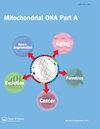现代树懒属和种(慢足科和巨足科)的有丝分裂基因组学系统发育关系
IF 0.6
4区 生物学
Q4 GENETICS & HEREDITY
引用次数: 10
摘要
摘要对39种树懒的有丝分裂全基因组进行了测序,其中19种为变种树懒,4种为三叉树懒,1种为pygmaeus, 1种为torquatus, 4种为diactylus, 10种为hoffmanni。贝叶斯树(BI)表明,大约在3100万年前(MYA,渐新世),Bradypus和Choloepus之间发生了时间分裂,而在中新世和上新世,每个属之间发生了其他主要分裂。单倍型网络(MJN)估计树懒属之间的时间分裂较低(约23.5 MYA)。两种方法检测到的祖先b torquatus作为第一个内部分歧Bradypus BI和19 MJN(21),紧随其后的是b . tridactylus的祖先。pygmaeus与b.s variegatus从共同祖先中分离的时间约为12 MYA (BI)或4.3 MYA (MJN)。不同种群间的分裂开始于8 MYA (BI)或3.6 MYA (MJN)。跨安第斯种群是第一个从现存的顺安第斯种群中分化出来的。跨安第斯异叶树种群相对于顺安第斯异叶树种群的遗传分化与不同种类树懒的遗传分化相似。有丝分裂基因组学分析表明,在圭亚那盾区,霍夫曼C.与双爪C.是有区别的。然而,来自哥伦比亚亚马逊地区标本的一只didactylus位于C. hoffmanni分支内。这可能是亚马逊河流域两个毛茛类群自然杂交的第一个例子,也可能是亚马逊河流域某些地区这两个物种存在不可分化表型的第一个例子。本文章由计算机程序翻译,如有差异,请以英文原文为准。
Mitogenomics phylogenetic relationships of the current sloth’s genera and species (Bradypodidae and Megalonychidae)
Abstract We sequenced the complete mitogenome of 39 sloths (19 Bradypus variegatus, 4 B. tridactylus, 1 B. pygmaeus, 1 B. torquatus, 4 Choloepus didactylus, and 10 C. hoffmanni). A Bayesian tree (BI) indicated a temporal split between Bradypus and Choloepus around 31 million years ago (MYA, Oligocene) and the other major splits within each genera during the Miocene and Pliocene. A haplotype network (MJN) estimated a lower temporal split between the sloth genera (around 23.5 MYA). Both methods detected the ancestor of B. torquatus as the first to diverge within Bradypus (21 for BI and 19 MJN), followed by that of the ancestor of B. tridactylus. The split of B. pygmaeus from the common ancestor with B. variegatus was around 12 MYA (BI) or 4.3 MYA (MJN). The splits among the previous populations of B. variegatus began around 8 MYA (BI) or 3.6 MYA (MJN). The trans-Andean population was the first to diverge from the remaining cis-Andean populations of B. variegatus. The genetic differentiation of the trans-Andean B. variegatus population relative to the cis-Andean B. variegatus is similar to that found for different species of sloths. The mitogenomic analysis resolved the differentiation of C. hoffmanni from the C. didactylus individuals of the Guiana Shield. However, one C. didactylus from the Colombian Amazon specimen was inside the C. hoffmanni clade. This could be the first example of possible natural hybridization in the Amazon of both Choloepus taxa or the existence of un-differentiable phenotypes of these two species in some Amazonian areas.
求助全文
通过发布文献求助,成功后即可免费获取论文全文。
去求助
来源期刊

Mitochondrial Dna Part a
Biochemistry, Genetics and Molecular Biology-Genetics
CiteScore
3.00
自引率
0.00%
发文量
6
期刊介绍:
Mitochondrial DNA Part A publishes original high-quality manuscripts on physical, chemical, and biochemical aspects of mtDNA and proteins involved in mtDNA metabolism, and/or interactions. Manuscripts on cytosolic and extracellular mtDNA, and on dysfunction caused by alterations in mtDNA integrity as well as methodological papers detailing novel approaches for mtDNA manipulation in vitro and in vivo are welcome. Descriptive papers on DNA sequences from mitochondrial genomes, and also analytical papers in the areas of population genetics, phylogenetics and human evolution that use mitochondrial DNA as a source of evidence for studies will be considered for publication. The Journal also considers manuscripts that examine population genetic and systematic theory that specifically address the use of mitochondrial DNA sequences, as well as papers that discuss the utility of mitochondrial DNA information in medical studies and in human evolutionary biology.
 求助内容:
求助内容: 应助结果提醒方式:
应助结果提醒方式:


